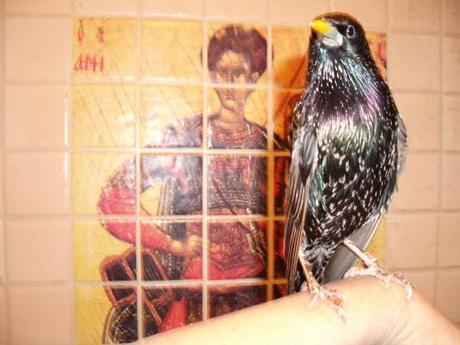 Oliver, the European Starling I rescued when he was just a baby
Oliver, the European Starling I rescued when he was just a baby
(read his story here)
Starlings are small to medium-sized birds found across the world.
Starlings have strong feet, their flight is strong and direct, and they are very gregarious. Their preferred habitat is fairly open country, and they eat insects and fruit. Several species live around human habitation, and are effectively omnivores.
Plumage of many species is typically dark with a metallic sheen. Most species nest in holes, laying blue or white eggs.
Starlings are talented mimics, with a repertoire of about 15–20 distinct imitations. Not only do they imitate the sounds of other birds, they also mimic man-made environmental sounds such as car alarms and human speech patterns. (My starling, Oliver, has an impressive song that mimics the sounds of my other birds — canaries, finches and lovebirds.) Starlings can recognize particular individuals by their calls, and are currently the subject of research into the evolution of human language.
Starlings are highly social, and associate in flocks that may include other species of starlings and sometimes species from other bird families.
A flock of starlings is called a murmuration.
Here’s an astonishing video taken by wildlife photographer Dylan Winter, of hundreds and hundreds of starlings flying in perfect coordination.
So how do they do it?
How do starlings fly in murmuratioins that number hundreds, even thousands of birds, turning and undulating in perfect formation of “all for one, and one for all”?
Brandon Keim writes for Wired, Nov. 8, 2011:
What makes possible the uncanny coordination of these murmurations, as starling flocks are so beautifully known? Until recently, it was hard to say. Scientists had to wait for the tools of high-powered video analysis and computational modeling. And when these were finally applied to starlings, they revealed patterns known less from biology than cutting-edge physics.
Starling flocks, it turns out, are best described with equations of “critical transitions” — systems that are poised to tip, to be almost instantly and completely transformed, like metals becoming magnetized or liquid turning to gas. Each starling in a flock is connected to every other. When a flock turns in unison, it’s a phase transition.
At the individual level, the rules guiding this are relatively simple. When a neighbor moves, so do you. Depending on the flock’s size and speed and its members’ flight physiologies, the large-scale pattern changes. What’s complicated, or at least unknown, is how criticality is created and maintained.
It’s easy for a starling to turn when its neighbor turns — but what physiological mechanisms allow it to happen almost simultaneously in two birds separated by hundreds of feet and hundreds of other birds? That remains to be discovered, and the implications extend beyond birds. Starlings may simply be the most visible and beautiful example of a biological criticality that also seems to operate in proteins and neurons, hinting at universal principles yet to be understood.
In other words, we don’t really know how starlings do it!
H/t my sis-in-law Shireen and FOTM’s swampygirl for the video.
~Eowyn

